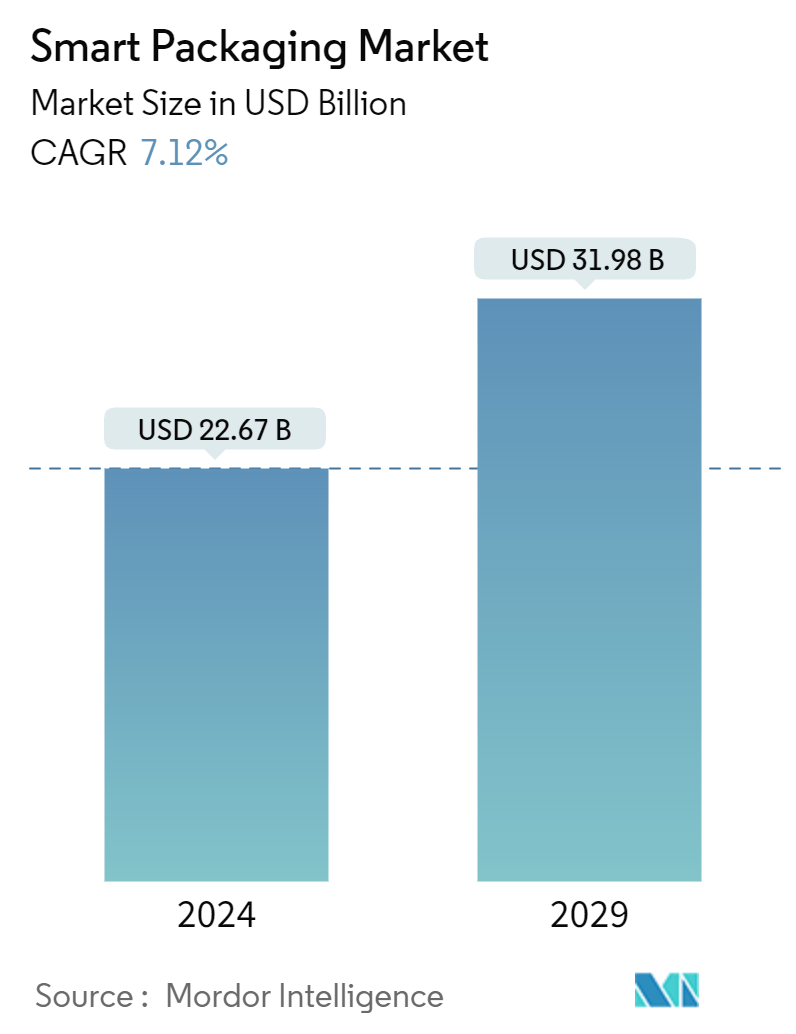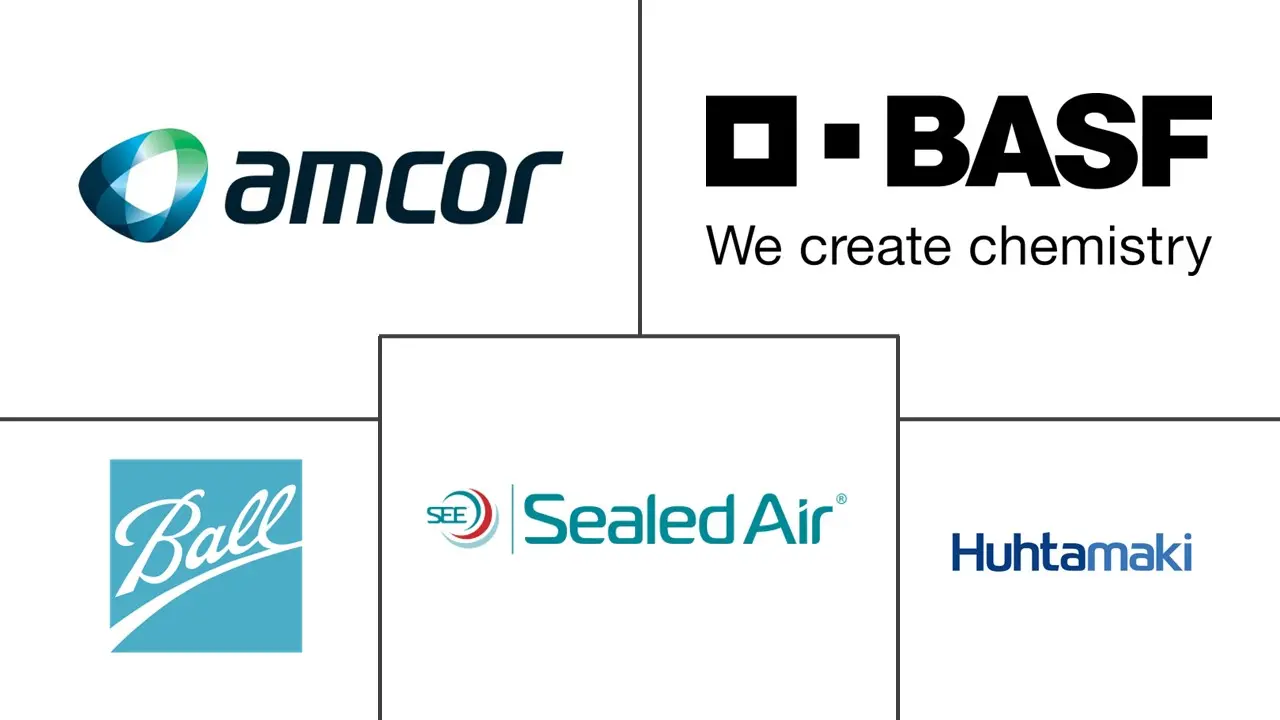Market Size of Smart Packaging Industry

| Study Period | 2019 - 2029 |
| Market Size (2024) | USD 22.67 Billion |
| Market Size (2029) | USD 31.98 Billion |
| CAGR (2024 - 2029) | 7.12 % |
| Fastest Growing Market | Asia Pacific |
| Largest Market | North America |
| Market Concentration | Low |
Major Players
*Disclaimer: Major Players sorted in no particular order |
Smart Packaging Market Analysis
The Smart Packaging Market size is estimated at USD 22.67 billion in 2024, and is expected to reach USD 31.98 billion by 2029, growing at a CAGR of 7.12% during the forecast period (2024-2029).
Smart packaging refers to a specific type of sensor-equipped packaging system used for various items, including food and medication. The technology used in smart packaging helps increase product quality, shelf life, freshness monitoring, and customer and product safety. When products are packaged using intelligent technology, these systems provide details about the product's quality and freshness.
- The smart packaging market's growth is driven by consumer lifestyle changes brought on by rapid urbanization and increased use of individualized personal items with advanced integrated innovation. The market depends on untapped geographic areas that offer enormous opportunities for competitors. Owing to increasing concern about health and hygiene, especially after the pandemic, the demand for sustainably packaged organic food has increased worldwide.
- According to the Dubai Chamber of Commerce and Industry Euromonitor, between 2020 and 2025, the growth rate of packaged staple food in the United Arab Emirates was the highest at 4%. In developing countries like India, China, Thailand, and Indonesia, the market for organic packaged food has recorded positive growth in the past few years. This is expected to lead to an increase in the demand for smart packaging in these countries in the future.
- According to a survey by YouGov in September 2023 about consumer spending on sustainable food products in India, 38% of the respondents were willing to pay 10% more for sustainably packaged food and drinks than conventionally packaged food products. On the other hand, 4% of respondents were willing to pay more than 100% for sustainably packaged food and beverages.
- Eco-smart packaging features a printed QR code on the outside of the box that connects to a webpage with all available product quick start guides (QSG). Customers can quickly download the PDF version corresponding to their new LMI product by scanning the QR code on the box with their smartphone and then perusing the QSGs on the associated homepage.
- Smart packaging also presents economic potential based on digitization, making it compatible with Industry 4.0. Sealed Air launched its digital packaging brand with a portfolio of design services, digital printing, and intelligent packaging solutions. Additionally, in October 2023, the digital technology studio Appetite Creative, in collaboration with packaging company Tetra Pak, launched a new interactive, innovative packaging for European fruit juice producer Rauch.
- However, the high cost of capital for installment, security issues, new techniques for fabricating such sensors and indicators compatible with packaging standards, and consumer awareness are vital restraints and challenges to the market's growth. Building a supporting infrastructure is an additional expense for end users who lack the infrastructure required to enable these package functionalities. To maximize the efficiency and efficacy of investments, every link in the supply chain has developed equivalent technological proficiency due to the existing market structure.
Smart Packaging Industry Segmentation
Smart packaging refers to systems with embedded sensor technology used with foods, pharmaceuticals, and many other products.
The smart packaging market is segmented by technology (active packaging and intelligent packaging), end-user vertical (food, beverage, healthcare, and personal care), and geography (North America (the United States and Canada), Europe (Germany, the United Kingdom, France, and Rest of Europe), Asia-Pacific (China, Japan, India, and Rest of Asia-Pacific), Latin America, and Middle East and Africa). Factors affecting the market's evolution in the near future, such as drivers and constraints, have been covered in the study. The market sizes and forecasts are provided in terms of value (USD) for all the above segments.
| By Technology | |
| Active Packaging | |
| Intelligent Packaging |
| By End-user Vertical | |
| Food | |
| Beverage | |
| Healthcare | |
| Personal Care | |
| Other End-user Verticals |
| By Geography | ||||||
| ||||||
| ||||||
| ||||||
| Latin America | ||||||
| Middle East and Africa |
Smart Packaging Market Size Summary
The smart packaging market is poised for significant growth, driven by advancements in technology that enhance product quality, safety, and shelf life. This market encompasses sensor-equipped packaging systems used for various products, including food and pharmaceuticals, and is increasingly influenced by consumer lifestyle changes and urbanization. The demand for smart packaging is further bolstered by the rising need for sustainable and hygienic packaging solutions, particularly in the wake of the pandemic. The market is also benefiting from the expansion of e-commerce, which is expected to increase the demand for active and intelligent packaging solutions that ensure product freshness and safety during transit.
In North America, particularly the United States and Canada, the smart packaging market is experiencing robust growth due to favorable regulatory conditions and a strong focus on sustainability. The integration of technologies such as RFID and sensors is enhancing supply chain efficiency and product traceability, especially in the food and healthcare sectors. Key players in the market are actively engaging in partnerships, innovations, and acquisitions to strengthen their market position and expand their product offerings. The competitive landscape remains moderately high, with major companies like Sealed Air Corporation, Amcor PLC, and BASF SE leading the charge in developing advanced packaging solutions that meet the evolving needs of consumers and businesses alike.
Smart Packaging Market Size - Table of Contents
-
1. MARKET INSIGHTS
-
1.1 Market Overview
-
1.2 Industry Attractiveness - Porter's Five Forces Analysis
-
1.2.1 Threat of New Entrants
-
1.2.2 Bargaining Power of Buyers
-
1.2.3 Bargaining Power of Suppliers
-
1.2.4 Threat of Substitutes
-
1.2.5 Intensity of Competitive Rivalry
-
-
1.3 Industry Value Chain Analysis
-
1.4 Impact of Key Macroeconomic Trends on the Market
-
-
2. MARKET SEGMENTATION
-
2.1 By Technology
-
2.1.1 Active Packaging
-
2.1.2 Intelligent Packaging
-
-
2.2 By End-user Vertical
-
2.2.1 Food
-
2.2.2 Beverage
-
2.2.3 Healthcare
-
2.2.4 Personal Care
-
2.2.5 Other End-user Verticals
-
-
2.3 By Geography
-
2.3.1 North America
-
2.3.1.1 United States
-
2.3.1.2 Canada
-
-
2.3.2 Europe
-
2.3.2.1 Germany
-
2.3.2.2 United Kingdom
-
2.3.2.3 France
-
2.3.2.4 Rest of Europe
-
-
2.3.3 Asia-Pacific
-
2.3.3.1 China
-
2.3.3.2 Japan
-
2.3.3.3 India
-
2.3.3.4 Rest of Asia-Pacific
-
-
2.3.4 Latin America
-
2.3.5 Middle East and Africa
-
-
Smart Packaging Market Size FAQs
How big is the Smart Packaging Market?
The Smart Packaging Market size is expected to reach USD 22.67 billion in 2024 and grow at a CAGR of 7.12% to reach USD 31.98 billion by 2029.
What is the current Smart Packaging Market size?
In 2024, the Smart Packaging Market size is expected to reach USD 22.67 billion.

